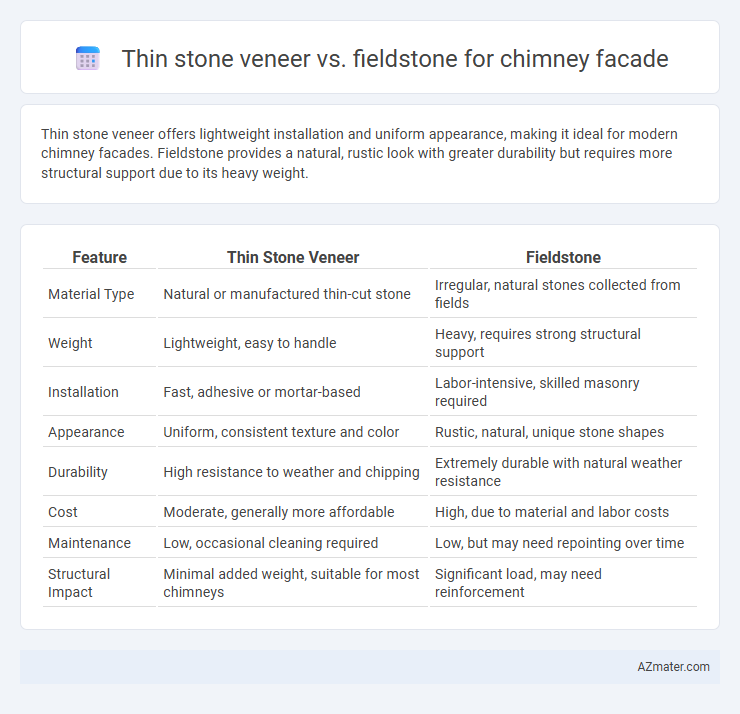Thin stone veneer offers lightweight installation and uniform appearance, making it ideal for modern chimney facades. Fieldstone provides a natural, rustic look with greater durability but requires more structural support due to its heavy weight.
Table of Comparison
| Feature | Thin Stone Veneer | Fieldstone |
|---|---|---|
| Material Type | Natural or manufactured thin-cut stone | Irregular, natural stones collected from fields |
| Weight | Lightweight, easy to handle | Heavy, requires strong structural support |
| Installation | Fast, adhesive or mortar-based | Labor-intensive, skilled masonry required |
| Appearance | Uniform, consistent texture and color | Rustic, natural, unique stone shapes |
| Durability | High resistance to weather and chipping | Extremely durable with natural weather resistance |
| Cost | Moderate, generally more affordable | High, due to material and labor costs |
| Maintenance | Low, occasional cleaning required | Low, but may need repointing over time |
| Structural Impact | Minimal added weight, suitable for most chimneys | Significant load, may need reinforcement |
Introduction to Chimney Façade Materials
Thin stone veneer offers a lightweight, cost-effective solution for chimney facades with easy installation and a variety of style options, while fieldstone provides a natural, rustic appearance with greater durability and heavier structural requirements. Both materials serve as protective and decorative elements, enhancing curb appeal and weather resistance. Selecting between thin stone veneer and fieldstone depends on factors like budget, aesthetic preference, and the chimney's structural capacity.
Overview: Thin Stone Veneer and Fieldstone
Thin stone veneer offers a lightweight, cost-effective option for chimney facades, fabricated from natural or manufactured stone slices that mimic full stone aesthetics without the bulk. Fieldstone, characterized by irregular shapes and natural textures, provides a rustic, authentic look sourced directly from quarries or collected naturally, demanding more structural support due to its weight. Both materials enhance chimney exteriors but differ significantly in installation complexity, durability, and visual texture.
Aesthetic Differences and Visual Impact
Thin stone veneer offers a sleek, uniform appearance with consistent color and texture, ideal for modern or refined chimney facades. Fieldstone displays a rugged, natural look with irregular shapes and varied hues, creating a rustic, organic visual impact. The choice between the two significantly influences the chimney's architectural style, with veneer providing a polished finish and fieldstone delivering authentic, earthy charm.
Installation Process: Thin Stone Veneer vs Fieldstone
Thin stone veneer offers a quicker installation process for chimney facades due to its lightweight nature and uniform thickness, allowing easy handling and adherence to various surfaces with mortar. Fieldstone installation is more labor-intensive and time-consuming, requiring careful selection, shaping, and fitting of irregular stones to create a structurally sound and aesthetically pleasing facade. Thin stone veneer minimizes labor costs and structural modifications compared to the heavy and complex installation demands of fieldstone.
Cost Comparison: Initial Investment and Long-Term Value
Thin stone veneer offers a lower initial investment cost compared to fieldstone, with prices typically ranging from $6 to $12 per square foot versus $15 to $30 per square foot for natural fieldstone. Fieldstone provides superior long-term value due to its durability and natural weather resistance, often reducing maintenance and repair expenses over time. Homeowners seeking budget-friendly installation may prefer thin stone veneer, while those prioritizing longevity and natural aesthetics might invest in fieldstone despite higher upfront costs.
Durability and Maintenance Requirements
Thin stone veneer offers a durable, lightweight option for chimney facades with low maintenance due to its engineered consistency and resistance to cracking, making it ideal for long-term performance. Fieldstone, while naturally robust and visually unique, may require regular sealing and mortar inspection to prevent weather-related deterioration and maintain structural integrity. Choosing between thin stone veneer and fieldstone depends on balancing initial installation complexity with long-term upkeep demands.
Weight and Structural Considerations
Thin stone veneer offers a lighter alternative to traditional fieldstone, significantly reducing the load on the chimney structure and foundation. Fieldstone, being naturally heavier and thicker, demands reinforced support to handle its substantial weight, which can increase construction costs and complexity. Choosing thin stone veneer minimizes structural modifications while providing the aesthetic appeal of natural stone, making it ideal for retrofit projects where weight constraints are critical.
Insulation and Energy Efficiency
Thin stone veneer offers superior insulation properties for chimney facades due to its lightweight design and ability to be installed with an insulating barrier, enhancing overall energy efficiency by reducing thermal bridging. Fieldstone, being thicker and more massive, provides natural thermal mass that helps stabilize indoor temperatures but may lack the added insulation layer, potentially leading to higher heat loss. Choosing thin stone veneer can optimize energy savings in modern construction by combining aesthetic appeal with advanced insulating materials.
Environmental Impact and Sustainability
Thin stone veneer offers a more environmentally sustainable option for chimney facades due to its reduced quarrying needs and lower transportation emissions compared to heavy fieldstone. Fieldstone, sourced naturally from local geological deposits, can have a minimal carbon footprint if locally obtained, but its substantial weight increases fuel consumption during transport and installation. Both materials can be reclaimed or recycled, yet thin stone veneer typically requires less extraction and processing, making it a greener choice for eco-conscious building projects.
Choosing the Right Material for Your Chimney Façade
Thin stone veneer offers a lightweight, cost-effective solution ideal for modern chimney facades, providing versatile design options with easier installation compared to natural stone. Fieldstone, known for its rugged, natural appearance and durability, imparts authentic texture that enhances rustic or traditional architectural styles. Selecting between thin stone veneer and fieldstone depends on budget, desired aesthetics, installation complexity, and long-term maintenance considerations for your chimney facade.

Infographic: Thin stone veneer vs Fieldstone for Chimney façade
 azmater.com
azmater.com